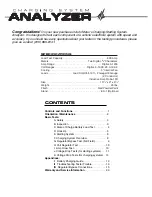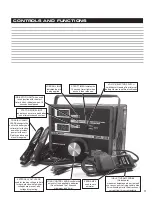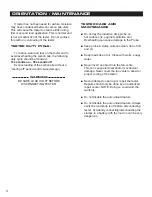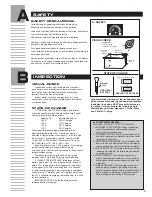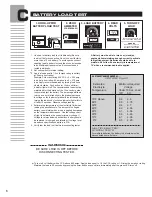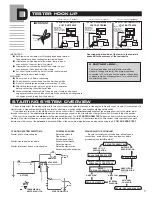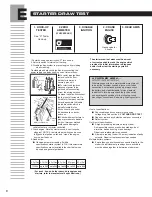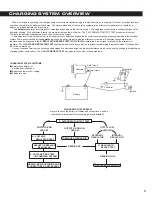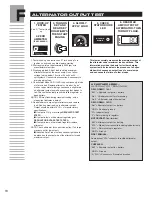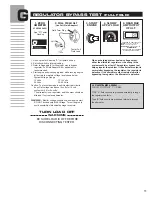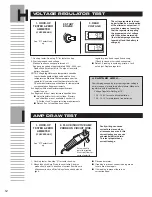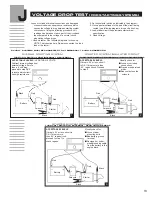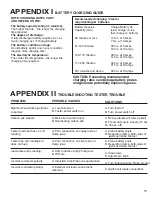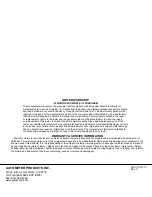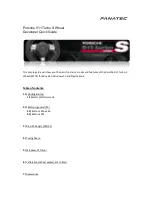
5
SAFETY
A
INSPECTION
B
SAFETY PRECAUTIONS:
Carefully read all operating instructions before using.
Wear eye protection when working around batteries.
Load knob must be off before attaching or removing load clamps
to prevent arcing and potential explosion.
Keep sparks, flames or cigarettes away from batteries.
Keep hair, hands, and clothing as well as tester leads and cords
away from moving blades and belts.
Provide adequate ventilation to remove car exhaust.
In extremely cold temperatures, check for frozen electrolytic fluid
before applying load.
Never connect large leads of this unit to more than a 12V battery.
Connection to 24 volts will dangerously overload the carbon pile
and circuitry. To test 24 volt systems see “D”.
VISUAL ChECk
Inspect and correct any frayed, glazed, cracked or
loose belts; cracks in battery case; loose or broken posts;
loose hold downs; low electrolyte level; corrosion on
terminal; Wet area around terminals.
Inspect starter, solenoid, and regulator for: Loose
connections, loose mounting of components, and frayed
or cracked wires.
STATE OF ChARGE
1. OPEN CELL BATTERIES- Using a hydrometer,
check the specific gravity of the electrolyte fluid. Typical
specific gravity values are as follows.
Reading Of:
Indicates Battery Is:
1.265
100% Charged
1.225
75% Charged
1.190
50% Charged
1.155
25% Charged
These specific gravity values are applicable to an
electrolytic temperature of 80°. The values must be
adjusted for temperatures other than 80°, to do this: Add
.004 for every 10 increments over 80°. Example: At 90°
1.265 +.004 =1.269. Subtract .004 for every 10° under
80°F. Example: at 70° 1.265 - .004 = 1.261.
Specific gravity must be 1.225 or above. If low, charge
per battery manufacturers specifications. Apply
a load equal to 1/2 cold crank amp rating for 5 seconds to
remove surface charge.
There should not be more than 50 points spread
between cells. If more than 50 points, replace battery.
2. SEALED TOP BATTERIES- (Maintenance Free)
Battery must be at 12.4 volts or above before testing. If
below 12.4, charge battery (See Appendix A) and apply
a load equal to 1/2 cold crank rating load for 5 seconds
to remove surface charge. Cold crank rating is explained
under section “C” Battery Load Test. If battery reads less
than 12.4 volts after recharging, replace battery. (6.2 volts
for 6 volt batteries)
IMPORTANT NOTE: A defective battery must be
replaced before proceeding.
Valid automotive electrical system testing depends on
all the components being in good operating condition.
In addition, the battery MuST have sufficient charge
for testing. Carefully perform the following before
attempting any electrical diagnosis. 1. Visual Check
and 2. State Of Charge.
A FURThER LOOk...
CAUSE OF BATTERY FAILURE.
1. INCORRECT APPLICATION: Wrong size battery
may have inadequate cold cranking rating for
original vehicle specifications.
2. INCORRECT INSTALLATION: Loose battery hold-
downs cause excessive vibration which can result
in damage to the plates.
3. IMPROPER MAINTENANCE: Low electrolytic fluid
and corrosion on battery connections, can greatly
reduce battery life and affect battery performance.
4. AGE OF BATTERy: If the date code on the battery
indicates it is fairly old, the failure may be caused
by natural causes.
5. OVERCHARGING: Overcharging caused by a
high voltage regulator setting or incorrect battery
charging can cause excessive gassing, heat and
water loss.
6. UNDERCHARGING Undercharging caused by a
faulty charging system or low voltage regulator
setting can cause lead sulfate to gradually build up
and crystalize on the plates greatly reducing the
battery’s capacity and ability to be recharged.
STATE OF CHARGE
VISuAL CHECk
A. SAFETY
Minimum
1.225
See “C” for tester hook-up.
Inspect For:
Frayed, glazed,
cracked or loose belt.
OpEn CELL
BATTERY
SEALED TOp BATTERY
Wet area
around
terminals
Corrosion on
terminals
Loose hold
downs
Loose or
broken posts
OR
OFF
LOAD
V
O
L
T
S
V
O
L
T
S


